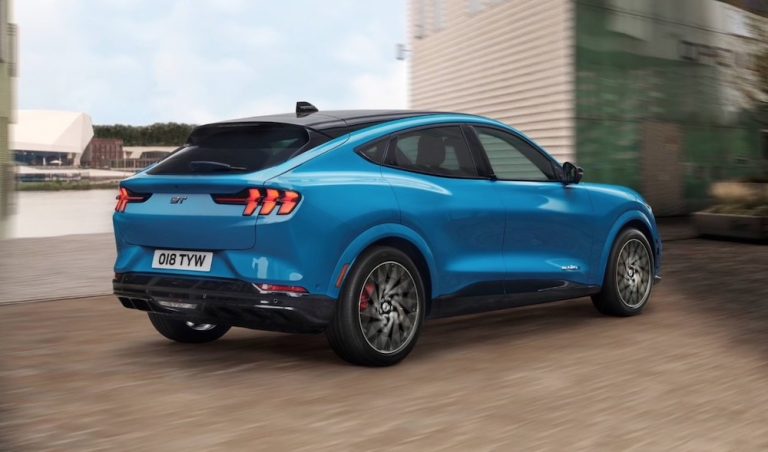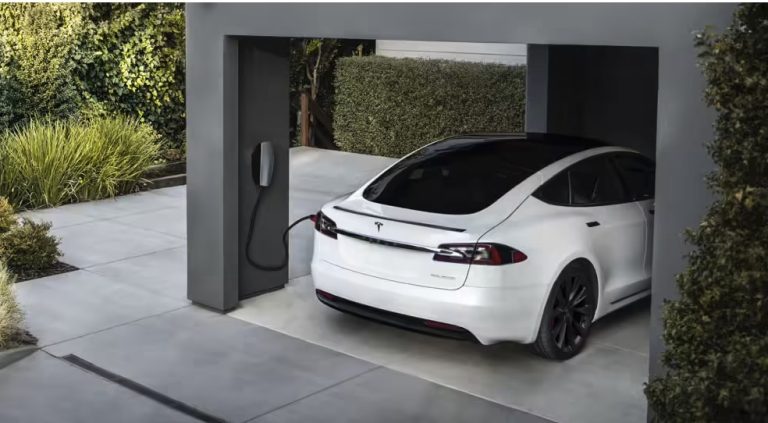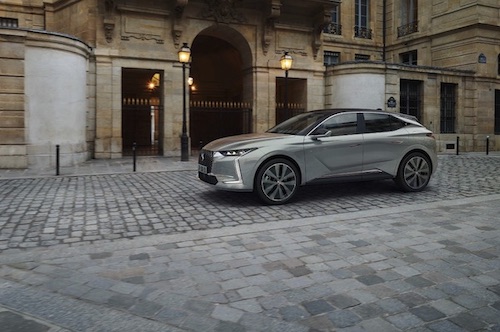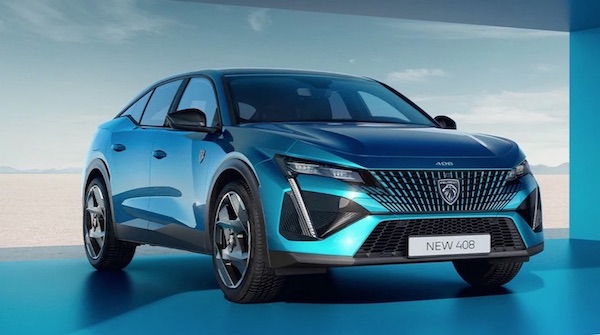Electric Cars: The Basics
For those of you new to zero-emission electric driving, we recommend a read of the following articles:
Sign up to the e-zoomed Electric Living newsletter
The DS 9 E-TENSE PHEV Saloon
DS Automobiles is a French luxury automotive brand, which was launched in 2009. Though it was initially part of the PSA Group (Citroën DS), it was launched as a standalone brand in 2014. The French marque was developed by the PSA Group to include a more premium brand in its portfolio. DS Automobiles was inspired by the original DS unveiled at the 1955 Paris Motor Show. The company is also involved with Formula E.
In fact, electrification has been part of the brands strategy from its creation. The company claims, ‘the lowest average CO2 emissions in Europe (100.2 g/km of CO2 according to the WLTP cycle per registered car in the first half of 2021) and more than a third of its cars are electrified. This strategy is accelerating: from 2024, every new DS Automobiles model will be exclusively 100% electric”.
The company currently has the following battery-electric vehicles (BEVs) and plug-in electric vehicles (PHEVs):
- DS 3 E-TENSE
- DS 4 E-TENSE Plug-In Hybrid
- DS 7 E-TENSE Plug-In Hybrid
- DS 9 E-TENSE Plug-In Hybrid
The DS 9 saloon has been available since 2020. The DS 9 is also based on the Efficient Modular Platform (EMP2 platform). Though the DS 9 PHEV has many positives i.e. a premium electric car, quality build, comfortable ride and a good level of standard features and onboard technology, in an ever changing world of electric cars, the DS 9 does not offer class-leading electric credentials.
The EV is available in two battery sizes: 11.9 kWh and 15.6 kWh. The smaller 11.9 kWh has a claimed emission-free electric range up to 51 km (WLTP) and for the 15.6 kWh, the claimed e-range is up to 67 km (WLTP). Of course, these need to be adjusted for real-world driving conditions, and expect the 11.9 kWh to achieve closer to 40 km electric range. Far from impressive compared to rivals, and with such a limited electric range, the benefits of electric driving are also limited.
The larger EV battery has more to offer. Expect a real-world zero-tailpipe emissions electric range closer to 55 km. Though not class-leading, still a useful emission-free e-range for families and company-car drivers, whose day-to-day needs are shorter commutes (work, gym, grocery store, school runs etc.). From the two EV battery options, in our view, it makes more sense to choose the larger battery. The longer the electric range, the lower the cost of motoring on e-mode!
Bottom-line, to truly leverage the benefits of driving a PHEV on electric mode, adequate electric range is imperative. If the electric vehicle (EV) is driven primarily using the internal combustion engine (ICE), it would be a significant challenge to achieve anywhere near the claimed fuel efficiency of the electric vehicle. The manufacturer claims up to 1.2 l/100 km. Like the real-world e-range, the real-world fuel economy will be less efficient!
Though the DS 9 PHEV has lower tailpipe emissions (26g – 43g CO2/km), compared to the conventional internal combustion engine (ICE) variant (155g CO2/km), the emissions are not class-leading. As an example, the Range Rover Sport plug-in hybrid has tailpipe emissions as low as 20 – 18g (CO2/km), which is certainly class-leading. Though worth keeping in mind that a PHEV driven on electric mode has zero-tailpipe emissions.
Like most PHEVs, the DS 9 saloon PHEV does not incorporate DC charging. However, not surprising, given the size of the onboard EV battery. The EV does incorporate a single-phase 7 kW AC onboard charger. We discourage using a 3-PIN domestic plug for charging an EV, and encourage the use of a dedicated residential EV charger like myenergi zappi.
Using a single-phase EV charger, the 11.9 kWh EV battery can be fully charged in 1 hour and 45 minutes (0%-100%). The 15.6 kWh onboard EV battery will take up to 2 hours and 25 minutes to achieve a 100% charge. Using a domestic socket will take significantly longer. We encourage plug-in hybrid owners to adopt a ‘topping up’ approach to charging an electric car. This way, there is always available emission-free electric range!
We also encourage businesses and families to install an on-site renewable energy system, like, a solar PV system or wind turbines, coupled with battery storage. It further enhances the benefits of electric driving, to include, zero-tailpipe ‘well-to-wheel’ emissions when driven on e-mode. Of course, there are also financial savings when a plug-in hybrid is driven on electric mode. Far cheaper than calling on the petrol engine!
The electric car is available in two variants, the front-wheel drive (FWD) E-TENSE 250, and the all-wheel drive (AWD) E-TENSE 4×4. The 1.6-litre petrol (4 cylinders) direct injection turbocharged DS 9 E-TENSE 250 plug-in hybrid can achieve 0-100 km/h in 8.1 seconds (maximum power: 250 hp/ torque: 360 Nm).
The top speed of the EV is 240 km/h. The DS 9 E-TENSE 4X4 plug-in hybrid can achieve 0-100 km/h in 5.6 seconds (maximum power: 360 hp/ torque: 520 Nm). The top speed of the EV is 250 km/h. The EV incorporates regenerative braking.
In terms of technology and features, the EV offers: rear parking sensors, front parking sensors, reversing camera – 180° Vision, cruise control with speed limiter, hill start assist, 12.3 inch digital instrument cluster, 12 inch HD touchscreen, Apple CarPlay and Android Auto. Other features include: emergency braking system, blind spot detection, lane keeping assist, extended traffic sign recognition and driver attention alert.
The interior cabin quality is premium, and does reflect the brands upmarket positioning and pricing. There is ample legroom and headroom, however, for taller adults seated at the rear, it may feel like a squeeze. The available boot space is 510 L.
Bottom-line, electric driving is good for the environment and the wallet!
| PROS | CONS |
|---|---|
| Attractive exterior styling | Electric range not class-leading |
| Comfortable ride | Tailpipe emissions not class-leading |
| Premium interior cabin | Expensive. Cheaper alternatives available |
The DS 9 E-TENSE PHEV Saloon (credit: DS Automobiles)
| At A Glance | |
|---|---|
| EV Type: | Plug-In Hybrid Electric Vehicle (PHEV) |
| Body Type: | Saloon |
| Engine: | Petrol-Electric |
| Available In Ireland: | Yes |
| Variants (1 Option) |
|---|
| DS 9 E-TENSE Rivoli + (from € 75,455) |
| EV Battery & Emissions | |
|---|---|
| EV Battery Type: | Lithium-ion |
| EV Battery Capacity: | Available in two battery sizes: 11.9 kWh/ 15.6 kWh |
| Charging: | DC Rapid Charging not available. Onboard charger: 7 kW AC (0%-100%: 1 hr 45 mins/ 2 hrs 25 mins) |
| Charge Port: | Type 2 |
| EV Cable Type: | Type 2 |
| Tailpipe Emissions: | 26g – 43g (CO2/km) |
| Battery Warranty: | 8 years or 160,000 km |
| Average Cost Of Residential Charging | |
|---|---|
| Battery net capacity : 8.8 kWh | € 2.10 |
| Battery net capacity : 11.6 kWh | € 2.78 |
| Battery net capacity : 12.0 kWh | € 2.87 |
| Battery net capacity : 13.10 kWh | € 3.14 |
| Battery net capacity : 14.10 kWh | € 3.37 |
- Note 1: The average cost of residential electricity in Ireland varies depending on the region, supplier and type of energy used. An average for Ireland is 23.97 cents/kWh.
- Note 2: Not all EV manufactures make available the data on net EV battery capacity, and in a number of instances the EV battery capacity advertised, does not state if it is gross or net capacity. In general, usable EV battery capacity is between 85% to 95% of the gross available capacity.
| Charging Times (Overview) | |
|---|---|
| Slow charging AC (3 kW – 3.6 kW): | 6 – 12 hours (dependent on size of EV battery & SOC) |
| Fast charging AC (7 kW – 22 kW): | 3 – 8 hours (dependent on size of EV battery & SoC) |
| Rapid charging AC (43 kW): | 0-80%: 20 mins to 60 mins (dependent on size of EV battery & SoC) |
- Note 1: SoC: state-of-charge
| Dimensions | |
|---|---|
| Height (mm): | 1460 |
| Width (mm): | 1855 |
| Length (mm): | 4934 |
| Wheelbase (mm): | 2895 |
| Turning Circle (m): | 11 |
| Boot Capacity (L): | 510 |
| DS 9 E-TENSE | |
|---|---|
| EV Battery Capacity: | 11.9 kWh/ 15.6 kWh |
| Electric Range (WLTP): | 51 – 67 km |
| Electric Energy Consumption (kWh/100km): | 15.5 – 17.2 |
| Fuel Consumption (l/100km): | 1.2 – 1.8 |
| Charging: | DC Rapid Charging not available. Onboard charger: 7 kW AC (0%-100%: 1 hr 45 mins/ 2 hrs 25 mins) |
| Top Speed: | 240 – 250 km/h |
| 0-100 km/h: | 5.6 – 8.1 seconds |
| Drive: | Front-wheel drive (FWD)/ All-Wheel Drive (AWD) |
| Electric Motor (kW): | 186 – 268 |
| Max Power (hp): | 250 – 360 |
| Torque (Nm): | 360 – 520 |
| Transmission: | Automatic |
| Seats: | 5 |
| Doors: | 4 |
| Kerb Weight (kg): | 1,839 – 1,909 |
| Colours: | 5 |
| NCAP Safety Rating: | Four-Star |
Electric Vehicles (EVs): Jargons
There is no doubt, in that, for those new to electric driving, the terminology can be both daunting and confusing. We have chosen a few jargons to help you get more familiar with electric vehicles (EVs)! We also recommend reading our article ‘Electric Car Jargon Buster‘ for a more comprehensive list of terms.
| Glossary: Electric Vehicles (EVs) | |
|---|---|
| Battery-Electric Vehicle (BEV): | What is a BEV? A battery-electric vehicle (BEV) is more commonly referred to as a pure electric car. A BEV is ‘pure’, in that, the vehicle only uses electric power for propulsion i.e. a BEV does not have an internal combustion engine (ICE). It is easy to recognise these zero-tailpipe emission green cars, as these vehicles are silent (except for the artificial noise), and do not have a tailpipe! |
| Frunk: | What is a frunk? Though a frunk is not a new term, its availability is becoming more widespread with the development of electric vehicles (EVs). A frunk is a storage space/ compartment/ trunk in the front of a vehicle, rather than the rear. In the case of pure electric cars, given that these vehicles do not have an onboard internal combustion engine (ICE), there is space for a frunk. It is worth noting that a frunk is usually much smaller than a trunk, and in EVs, a good space for storing the EV cable. |
| Mild Hybrid Electric Vehicles (MHEVs): | What is a MHEV? Mild hybrids use both an internal combustion engine (ICE) and an electric motor. These cars are also known as ‘self-charging hybrids’. The vehicle uses regenerative braking (recuperated electric energy) to improve the fuel efficiency and to reduce tailpipe emissions (CO2 g/km). However, mild hybrids cannot be charged by an external power source, like an EV charger. |
| Plug-In Hybrid Electric Vehicle (PHEV): | What is a PHEV? Like a MHEV, a plug-in hybrid electric vehicle (PHEV) aims to increase the fuel efficiency and reduce tailpipe emissions. However there is much difference between a PHEV and a MHEV. A PHEV has a more powerful electric motor and a larger onboard EV battery. In a PHEV, the electric motor and onboard EV battery are also used to propel the electric vehicle. Moreover, a PHEV battery is charged by using an external power source, like a dedicated EV charger. |
| Regenerative Braking: | What is regenerative braking? Also known as regen braking or brake recuperation, regenerative braking is a process of capturing the wasted energy (during braking) from an electric vehicle, to be reused (recycled). In the case of electric driving, the ‘captured’ energy is reused to increase the pure electric range of the EV. |
While e-zoomed uses reasonable efforts to provide accurate and up-to-date information, some of the information provided is gathered from third parties and has not been independently verified by e-zoomed. While the information from the third party sources is believed to be reliable, no warranty, express or implied, is made by e-zoomed regarding the accuracy, adequacy, completeness, legality, reliability or usefulness of any information. This disclaimer applies to both isolated and aggregate uses of this information.






























